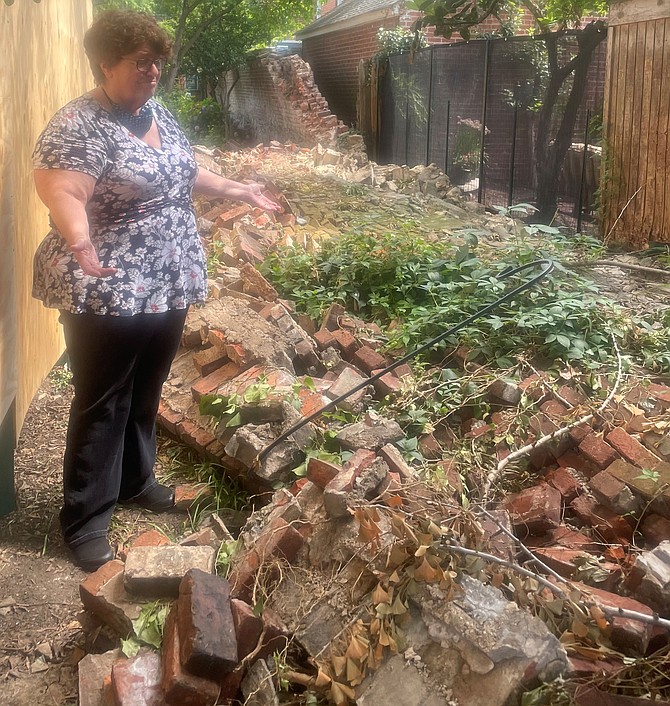Lee-Fendall House Museum and Garden Executive Director Martha Withers stands among the rubble of the collapsed wall at the historic property. Janet Barnett/Gazette Packet
“We are a small nonprofit. Insurance is not going to cover this, so we are counting on the goodwill of the community to help us.” — Lee-Fendall House Executive Director Martha Withers
A 70-foot section of the brick wall surrounding the garden of the Lee-Fendall House, one of the most historic properties in Alexandria, collapsed without warning June 12 just minutes after the last visitor had departed the area.
“The wall fell down about five minutes after the last person left the garden,” said Martha Withers, Executive Director of the Lee-Fendall House Museum and Garden. “We got a call from a neighbor – we didn’t hear anything inside – and came out to find about 70 feet of the wall on the ground.”
No injuries were reported but now the historic property is facing the financial challenge of rebuilding the wall, which surrounds the garden of the 1785 home at the corner of Oronoco and N. Washington streets in Old Town.
“The wall has been standing for about 220 years,” Withers said. “It is all handmade brick with stone laid under it to keep brick from absorbing water. At least one brick still has a thumb print in it – probably that of one of the enslaved workers.”
Lee-Fendall House is the city's only privately operated history museum. It relies on donations and community support to maintain the property and provide tours and educational programs. It has established a Repair the Wall campaign in hopes of raising the $125,000 estimated to rebuild the wall.
“We are a small nonprofit,” Withers said. “Insurance is not going to cover this so we are counting on the goodwill of the community to help us.”
Withers said that the rebuilding will take place in phases.
“We first need to get everything stabilized,” Withers said. “We have to move and clean all of the brick and stone to preserve as much as possible and have an engineering firm working on plans for us for a new foundation. Then we will rebuild so that it looks like the original wall but instead of being four layers of brick thick, it will be a façade on the outside of something that is more stable.”
The organization is working closely with the Board of Architectural Review and with local firms specializing in historic masonry on a multi-phase plan to repair the wall. A temporary wall has been constructed for safety purposes and to enclose the area that is used for programs and private events.
Since its construction in 1785, the Lee-Fendall House has housed 37 members of the Lee family (1785–1903), hundreds of convalescing Union soldiers during the Civil War (1863–1865), the prominent Downham family (1903–1937), and powerful labor leader John L. Lewis (1937–1969). Throughout its history, the home was also lived and worked in by generations of enslaved and free African Americans.
The historic home is listed on the National Register of Historic Places and is now owned and operated by the Virginia Trust for Historic Preservation. It is run as a museum to preserve the architectural and historic value of the house and gardens and to educate visitors through tours and interpretive programs.
“This will be a major project for the museum,” Withers added. “The wall managed to stand for 220 years. Now we need to get it back looking like it did and are hoping that we can rely on the Alexandria community to support this critical repair.”
For more information or to donate to the Repair the Wall Fund, visit http://www.leefendallhouse.org/.


